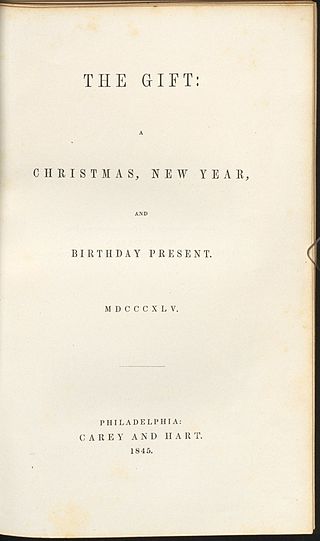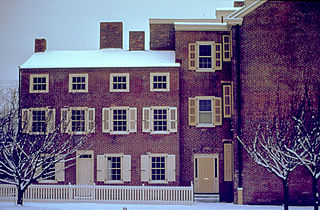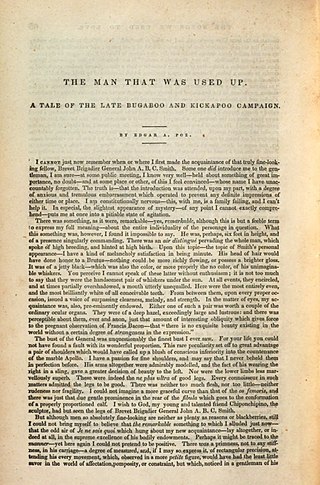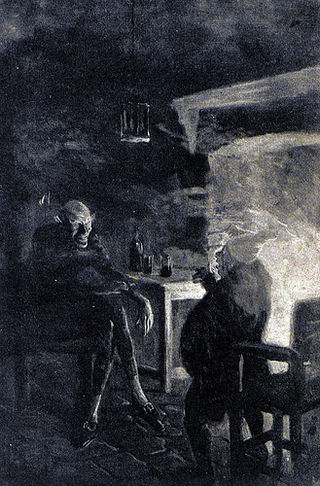
"The Balloon-Hoax" is the title used in collections and anthologies of a newspaper article by American writer Edgar Allan Poe, first published in 1844 in The Sun newspaper in New York. Originally presented as a true story, it detailed European Monck Mason's trip across the Atlantic Ocean in only three days in a gas balloon. It was later revealed as a hoax and the story was retracted two days later.

"The Purloined Letter" is a short story by American author Edgar Allan Poe. It is the third of his three detective stories featuring the fictional C. Auguste Dupin, the other two being "The Murders in the Rue Morgue" and "The Mystery of Marie Rogêt". These stories are considered to be important early forerunners of the modern detective story. It first appeared in the literary annual The Gift for 1845 (1844) and soon was reprinted in numerous journals and newspapers.

"The Conqueror Worm" is a poem by Edgar Allan Poe about human mortality and the inevitability of death. It was first published separately in Graham's Magazine in 1843, but quickly became associated with Poe's short story "Ligeia" after Poe added the poem to a revised publication of the story in 1845. In the revised story, the poem is composed by the eponymous Ligeia, and taught to the narrator in the fits of her death throes.

Frances Sargent Osgood was an American poet and one of the most popular women writers during her time. Nicknamed "Fanny", she was also famous for her exchange of romantic poems with Edgar Allan Poe.

"Al Aaraaf" is an early poem by American writer Edgar Allan Poe, first published in 1829. It tells of the afterlife in a place called Al Aaraaf, inspired by A'raf as described in the Quran. At 422 lines, it is Poe's longest poem.

"The Facts in the Case of M. Valdemar" is a short story by the American author Edgar Allan Poe about a mesmerist who puts a man in a suspended hypnotic state at the moment of death. An example of a tale of suspense and horror, it is also to a certain degree a hoax, as it was published without claiming to be fictional, and many at the time of publication (1845) took it to be a factual account. Poe admitted it to be a work of pure fiction in letters to his correspondents.

The Edgar Allan Poe National Historic Site is a preserved home once rented by American author Edgar Allan Poe, located at 532 N. 7th Street, in the Spring Garden neighborhood of Philadelphia, Pennsylvania. Though Poe lived in many houses over several years in Philadelphia, it is the only one which still survives. It was designated a National Historic Landmark in 1962.
"The Spectacles" is a short story by Edgar Allan Poe, published in 1844. It is one of Poe's comedy tales.

"Eleonora" is a short story by American writer Edgar Allan Poe, first published in 1842 in Philadelphia in the literary annual The Gift. It is often regarded as somewhat autobiographical and has a relatively "happy" ending.

"The Oblong Box" is a short story by American writer Edgar Allan Poe, first published in 1844, about a sea voyage and a mysterious box.

"Maelzel's Chess Player" (1836) is an essay by Edgar Allan Poe exposing a fraudulent automaton chess player called The Turk, which had become famous in Europe and the United States and toured widely. The fake automaton was invented by Wolfgang von Kempelen in 1769 and was brought to the U.S. in 1825 by Johann Nepomuk Mälzel after von Kempelen's death.

The Conchologist's First Book is an illustrated textbook on conchology issued in 1839, 1840, and 1845. The book was originally printed under Edgar Allan Poe's name. The text was based on Manual of Conchology by Thomas Wyatt, an English author and lecturer.

Graham's Magazine was a nineteenth-century periodical based in Philadelphia established by George Rex Graham and published from 1840 to 1858. It was alternatively referred to as Graham's Lady's and Gentleman's Magazine, Graham's Magazine of Literature and Art, Graham's American Monthly Magazine of Literature and Art, and Graham's Illustrated Magazine of Literature, Romance, Art, and Fashion.

"Tamerlane" is a poem by Edgar Allan Poe that follows a fictionalized accounting of the life of a Turco-Mongol conqueror historically known as Tamerlane. The poem was first published in the 1827 collection Tamerlane and Other Poems. That collection, with only 50 copies printed, was not credited with the author's real name but by "A Bostonian". The poem's original version was 403 lines but trimmed down to 223 lines for its inclusion in Al Aaraaf, Tamerlane, and Minor Poems.

"The Man That Was Used Up", sometimes subtitled "A Tale of the Late Bugaboo and Kickapoo Campaign", is a short story and satire by Edgar Allan Poe. It was first published in August 1839 in Burton's Gentleman's Magazine.

"Thou Art the Man", originally titled "Thou Art the Man!", is a short story by Edgar Allan Poe, first published in 1844. It is an early experiment in detective fiction, like Poe's "The Murders in the Rue Morgue", though it is generally considered an inferior story.

"Bon-Bon" is a comedic short story by Edgar Allan Poe, first published in December 1832 in the Philadelphia Saturday Courier. Originally called "The Bargain Lost", it follows Pierre Bon-Bon, who believes himself a profound philosopher, and his encounter with the Devil. The story's humor is based on the verbal interchange between the two, which satirizes classical philosophers such as Plato and Aristotle. The Devil reveals that he has eaten the souls of many of these philosophers.

The Opal: A Pure Gift for the Holy Days, was an annual gift book, founded by Rufus Wilmot Griswold and published in New York by John C. Riker, from 1844 to 1849. Content included short stories, illustrations and poems.

The works of American author Edgar Allan Poe include many poems, short stories, and one novel. His fiction spans multiple genres, including horror fiction, adventure, science fiction, and detective fiction, a genre he is credited with inventing. These works are generally considered part of the Dark romanticism movement, a literary reaction to Transcendentalism. Poe's writing reflects his literary theories: he disagreed with didacticism and allegory. Meaning in literature, he said in his criticism, should be an undercurrent just beneath the surface; works whose meanings are too obvious cease to be art. Poe pursued originality in his works, and disliked proverbs. He often included elements of popular pseudosciences such as phrenology and physiognomy. His most recurring themes deal with questions of death, including its physical signs, the effects of decomposition, concerns of premature burial, the reanimation of the dead, and mourning. Though known as a masterly practitioner of Gothic fiction, Poe did not invent the genre; he was following a long-standing popular tradition.
David Poe Jr. was an American actor and the father of Edgar Allan Poe.


















